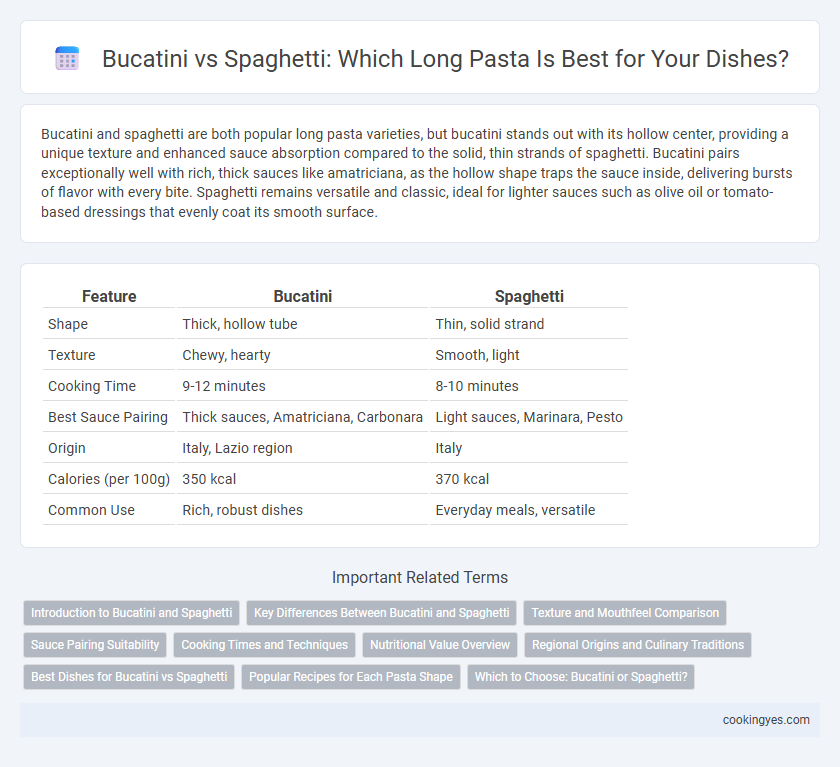Bucatini and spaghetti are both popular long pasta varieties, but bucatini stands out with its hollow center, providing a unique texture and enhanced sauce absorption compared to the solid, thin strands of spaghetti. Bucatini pairs exceptionally well with rich, thick sauces like amatriciana, as the hollow shape traps the sauce inside, delivering bursts of flavor with every bite. Spaghetti remains versatile and classic, ideal for lighter sauces such as olive oil or tomato-based dressings that evenly coat its smooth surface.
Table of Comparison
| Feature | Bucatini | Spaghetti |
|---|---|---|
| Shape | Thick, hollow tube | Thin, solid strand |
| Texture | Chewy, hearty | Smooth, light |
| Cooking Time | 9-12 minutes | 8-10 minutes |
| Best Sauce Pairing | Thick sauces, Amatriciana, Carbonara | Light sauces, Marinara, Pesto |
| Origin | Italy, Lazio region | Italy |
| Calories (per 100g) | 350 kcal | 370 kcal |
| Common Use | Rich, robust dishes | Everyday meals, versatile |
Introduction to Bucatini and Spaghetti
Bucatini is a thick, hollow pasta resembling spaghetti but with a unique central hole that enhances sauce absorption and texture in dishes. Spaghetti, a long, thin, solid pasta, serves as the classic choice for a wide variety of traditional Italian recipes due to its versatility and smooth surface. Both pastas excel in different culinary uses, with bucatini offering a heartier bite and spaghetti favored for light, delicate sauces.
Key Differences Between Bucatini and Spaghetti
Bucatini features a hollow center that allows sauces to cling inside the pasta, enhancing flavor absorption, while spaghetti is solid and provides a smoother texture. Bucatini's thicker diameter offers a chewier bite, contrasting with spaghetti's thinner, more delicate strands. These structural differences affect cooking times and pairings, with bucatini often favored for richer, chunkier sauces and spaghetti suited for lighter, smoother sauces.
Texture and Mouthfeel Comparison
Bucatini offers a thicker, hollow structure that provides a unique chewy texture and allows sauce to fill the center, enhancing each bite's mouthfeel. Spaghetti features a thinner, solid strand that delivers a smoother, more delicate texture, ideal for lighter sauces or simple preparations. The contrast between bucatini's substantial, hearty chew and spaghetti's sleek, tender bite makes them suited to different culinary experiences based on texture preference.
Sauce Pairing Suitability
Bucatini's hollow center makes it ideal for holding thicker, chunkier sauces like Amatriciana or rich tomato-based ragu, allowing the flavors to penetrate the pasta for a more flavorful bite. Spaghetti pairs best with lighter, smooth sauces such as aglio e olio, carbonara, or simple marinara, as its solid strands evenly coat without overwhelming the palate. Choosing bucatini enhances dishes with hearty sauces, while spaghetti excels with delicate, oil or cream-based sauces for balanced flavor distribution.
Cooking Times and Techniques
Bucatini requires a slightly longer cooking time of 9 to 12 minutes compared to spaghetti's 8 to 10 minutes, due to its thicker, hollow structure. Cooking bucatini demands careful attention to avoid undercooked centers, often involving stirring to prevent sticking inside the tube. Spaghetti's thinner strands cook faster and evenly, making it ideal for delicate sauces and quick preparation techniques.
Nutritional Value Overview
Bucatini and spaghetti share similar macronutrient profiles, with both providing approximately 200 calories and 7 grams of protein per 2-ounce serving of dry pasta. Bucatini features a hollow center, slightly increasing its carbohydrate content and fiber, which can aid digestion. Both pastas are low in fat and offer essential B vitamins and minerals, but whole wheat or enriched varieties enhance their overall nutritional value.
Regional Origins and Culinary Traditions
Bucatini originates from the Lazio region, especially Rome, and is characterized by its hollow center, which allows it to hold rich sauces like amatriciana, reflecting its traditional Roman culinary heritage. Spaghetti, widely associated with Naples and southern Italy, features a solid, thin form ideal for lighter tomato-based sauces such as marinara, embodying the simple yet vibrant flavors of Neapolitan cuisine. These regional origins influence their culinary uses, with bucatini favored for hearty, robust dishes and spaghetti for more delicate, sauce-driven preparations.
Best Dishes for Bucatini vs Spaghetti
Bucatini, with its hollow center, excels in rich, hearty sauces like Amatriciana or carbonara, allowing the sauce to cling inside and enhance every bite. Spaghetti, being solid and thin, is perfect for lighter sauces such as aglio e olio or classic marinara, providing a balanced texture and easy coating. Both pastas shine in dishes tailored to their unique structures, making bucatini ideal for robust, saucy recipes and spaghetti suited for delicate, smooth sauces.
Popular Recipes for Each Pasta Shape
Bucatini, a hollow long pasta, is essential in classic Roman dishes like Bucatini all'Amatriciana, where its tube shape captures rich tomato and guanciale sauce perfectly. Spaghetti, renowned worldwide, features prominently in popular recipes such as Spaghetti Carbonara and Spaghetti Aglio e Olio, which rely on its slender, solid form to evenly coat and meld with creamy or oily sauces. Both pastas excel in delivering distinct textures that complement their signature recipes, highlighting their unique culinary roles in Italian cuisine.
Which to Choose: Bucatini or Spaghetti?
Bucatini offers a unique texture with its hollow center that allows sauces to cling inside, providing an intense flavor experience ideal for rich, chunky sauces like amatriciana. Spaghetti, a classic choice, delivers a smooth surface perfect for lighter, oil-based or tomato sauces, making it versatile for everyday meals. Choosing between bucatini and spaghetti depends on the sauce type and desired texture, with bucatini enhancing robust dishes and spaghetti complementing delicate flavors.
Bucatini vs spaghetti for long pasta Infographic

 cookingyes.com
cookingyes.com